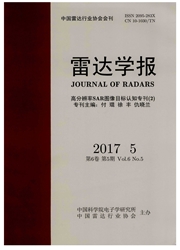

 中文摘要:
中文摘要:
与空时自适应处理(STAP)相比,机载雷达空时自适应检测(STAD)方法利用待检测单元及训练样本的数据形成合理的检测统计量,直接判定目标的有无,而不用先进行杂波抑制,然后再检测。STAD 方法具有处理流程简洁、设计灵活等特点,而且其相应的检测统计量通常具有恒虚警率(CFAR)特性,因而不需要进行专门的CFAR处理。更为重要的是,STAD往往比杂波抑制后检测的传统方法具有更好的检测性能。该文首先对STAD的技术要点进行简要地概括,然后对现有的STAD方法进行分类介绍,最后对STAD的下一步研究进行展望。
 英文摘要:
英文摘要:
Compared with Space-Time Adaptive Processing (STAP), Space-Time Adaptive Detection (STAD) employs the data in the cell under test and those in the training to form reasonable detection statistics and consequently decides whether the target exists or not. The STAD has concise processing procedure and flexible design. Furthermore, the detection statistics usually possess the Constant False Alarm Rate (CFAR) property, and hence it needs no additional CFAR processing. More importantly, the STAD usually exhibits improved detection performance than that of the conventional processing, which first suppresses the clutter then adopts other detection strategy. In this paper, we first summarize the key strongpoint of the STAD, then make a classification for the STAD, and finally give some future research tracks.
 同期刊论文项目
同期刊论文项目
 同项目期刊论文
同项目期刊论文
 Adaptive double subspace signal detection in Gaussian background-part II: partially homogeneous envi
Adaptive double subspace signal detection in Gaussian background-part II: partially homogeneous envi Fisher information matrix, Rao test, and Wald test for complex-valued signals and their applications
Fisher information matrix, Rao test, and Wald test for complex-valued signals and their applications 期刊信息
期刊信息
